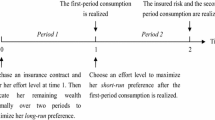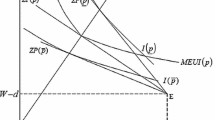Abstract
The purpose of this research is to investigate the value of demand information in an insurance market under both demand and cost uncertainty, something not previously considered in the literature. Thus, the contribution of this research is to shed light on the characteristics of the value of demand information in an insurance market under demand and cost uncertainty. The main results of this research are as follows. First, the value of demand information is always positive in an insurance market under both demand and cost uncertainty. This result shows that the value of demand information is also positive even if both demand and cost uncertainty coexist. Second, increases in demand uncertainty and the investment parameter and a decrease in cost uncertainty raise the value of demand information. From this result, we find that demand and cost uncertainty have opposite effects on the value of demand information. Third, whether an increase in the number of insurance firms raises the value of demand information depends on the magnitude of cost uncertainty. When cost uncertainty is very low (high), an increase in the number of insurance firms lowers (raises) the value of demand information.
Similar content being viewed by others
Notes
As explained in many insurance texts, cost uncertainty can be reduced by the law of large numbers. However, cost uncertainty remains in practice. Evidence is that insurance firms include “reserves for unexpected losses (unforeseen contingencies)” in insurance premiums. For details, see Dorfman (2008) and Black et al. (2013).
For example, Gibbons (1992) covers how to solve such dynamic games of complete information. The Stackelberg model is one of the well-known models categorized by this game.
Proof provided in Appendix B.
Proof provided in Appendix C.
Proof provided in Appendix D.
Proof provided in Appendix E.
The second-order condition is always satisfied.
When Eq. A.5 is not satisfied, r ∗ i = 0.
\( \overline{r} \) in Eq. A.7 always exists because
$$ 2\left(a-{\mu}_x\right)/{\sigma}_x^2-\left[2\left(n+2\right)\left(a-{\mu}_x\right){\sigma}_x^2/\left\{4c{\left(n+1\right)}^2+n\left(n-2\right){\sigma}_x^4\right\}\right]=2\left(a-{\mu}_x\right)\left[4c{\left(n+1\right)}^2+\left\{n\left(n-3\right)-2\right\}{\sigma}_x^4\right]/\left[\left\{4c{\left(n+1\right)}^2+n\left(n-2\right){\sigma}_x^4\right\}{\sigma}_x^2\right]>0 $$q ∗ i ≥ 0 and p ∗ ≥ 0 are always satisfied because we can prove that 2c(n + 1)2 − (n − 2)σ 4 x > 0 is always satisfied as follows. 2c(n + 1)2 − (n − 2)σ 4 x > 0 can be transformed as σ 4 x < 2c(n + 1)2/(n − 2). Equation A.5 can be transformed as σ 4 x < c(n + 1)2/n. Because 2c(n + 1)2/(n − 2) > c(n + 1)2/(n − 2), 2c(n + 1)2 − (n − 2)σ 4 x > 0 is always satisfied.
h(n) ≡ n(24 + n(n − 9)) − 4 > 0 is easily proved because h(n) becomes the minimum value in the case of n = 4, and then, h(4) = 12 > 0.
This maximum value of σ 2 x comes from Eq. A.5.
However, we cannot know how the magnitude of σ 2 x globally affects the value of demand information because Ξ is not a monotone function of σ 2 x .
The maximum \( \overline{r} \) can be found in Eq. A.8.
References
Asplund, M. (2002). Risk-averse firms in oligopoly. International Journal of Industrial Organization, 20, 995–1012.
Basar, T., and Ho, Y. (1974). Informational properties of the Nash solutions of two stochastic nonzero-sum games. Journal of Economic Theory, 7, 370–387.
Black, Jr., K., Skipper, H. D., and Black III, K. (2013). Life insurance (14th edition). Lucretian, LLC
Clarke, R. N. (1983). Duopolists don’t wish to share information. Economics Letters, 11, 33–36.
Dorfman, M. S. (2008). Introduction to risk management and insurance (9th ed.). New Jersey: Pearson Prentice Hall.
Gal-Or, E. (1986). Information transmission—Cournot and Bertrand equilibria. Review of Economic Studies, 53(1), 85–92.
Kreps, D., and Scheinkman, J. (1983). Quantity pre-commitment and Bertrand competition yield Cournot outcomes. Bell Journal of Economics, 14, 326–337.
Larue, B., and Yapo, V. (2000). Asymmetries in risk and in risk attitude: The duopoly case. Journal of Economics and Business, 52, 435–453.
Levine, P., and Ponssard, J.-P. (1979). The value of information in some nonzero sum games. International Journal of Game Theory, 6, 221–229.
Polborn, M. K. (1998). A model of an oligopoly in an insurance market. Geneva Papers on Risk and Insurance Theory, 23, 41–48.
Sakai, Y. (1985). The value of information in a simple duopoly model. Journal of Economic Theory, 36(1), 36–54.
Sakai, Y. (1986). Cournot and Bertrand equilibria under imperfect information. Journal of Economics, 46(3), 213–232.
Sakai, Y. (1993). The role of information in profit-maximizing and labor-managed duopoly models. Managerial and Decision Economics, 14(5), 419–432.
Sakai, Y., & Yamato, T. (1990). On the exchange of cost information in a Bertrand-type duopoly model. Economic Studies Quarterly, 41(1), 48–64.
Sakai, Y., and Yoshizumi, A. (1991). The impact of risk aversion on information transmission between firms. Journal of Economics, 53, 51–73.
Seog, H. S. (2010). The economics of risk and insurance. West Sussex: Wiley-Blackwell
Shy, O. (1995). Industrial organization: Theory and applications. Cambridge: MIT Press
Vives, X. (1984). Duopoly information equilibrium: Cournot and Bertrand. Journal of Economic Theory, 34, 71–94.
Acknowledgments
The author wishes to thank the editor and anonymous reviewer for their comments. The author would like to acknowledge the financial support by the Japanese Ministry of Education, Culture, Sports, Science and Technology in the form of a Grant-in-Aid for Young Scientists (B), 24730362.
Author information
Authors and Affiliations
Corresponding author
Appendices
Appendix A
Consider the case in which all insurance firms have demand information. In the second stage, each insurance firm chooses its own quantity to satisfy the following first-order conditionFootnote 9:
Because all insurance firms are identical, q ∗1 = q ∗2 = ⋯ = q ∗ n is realized. From Eq. A.1, the equilibrium quantity can be derived as
where an asterisk denotes an equilibrium value. Substituting Eq. A.2 into Eq. 9 yields
In the first stage, each insurance firm chooses its investment level to satisfy the following first-order condition:
In order to satisfy the second-order condition, the following condition is assumed to be satisfiedFootnote 10:
Because all insurance firms are identical, r ∗1 = r ∗2 = ⋯ = r ∗ n is realized. From Eq. A.4, the equilibrium amount of investment is derived as follows:
In order to confirm that r ∗ i is always positive, the following lemma must be checked.
Lemma 1: 4c(n + 1)2 + {(n − 3)n − 2}σ 4 x > 0 is always satisfied.
Proof:
Let f(n) ≡ 4c(n + 1)2 + {(n − 3)n − 2}σ 4 x . f(n) is a monotone increasing function of n. Thus, we confirm that f(n) becomes strictly positive in the case of n = 2. From Eq. A.5, we find that \( {\sigma}_x^2<\sqrt{9c/2} \), and thus, f(2) = 4(9c − σ 2 x ) > 0 is proved. Q. E. D.
In order to guarantee that \( \overline{r}\ge {r}_i \), it is assumed that \( \overline{r} \) satisfies the following condition: Footnote 11
Combining Eqs. 10 and A.7 yields
By substituting Eq. A.6 into Eqs. 3, A.2, and A.3, the following equilibrium values of the quantity, insurance premium, and certainty equivalent can be derived respectively as followsFootnote 12:
Appendix B
To determine the value of demand information in an insurance market, we compare the case in which insurance firms have demand information with the case in which they do not. Having discussed the former case in Appendix A, we now consider the other case.
When no insurance firms have demand information, the demand function is given by Eq. 4 rather than Eq. 3. Although these two demand functions differ, the same procedure is used to derive the equilibrium. Thus, under the case in which insurance firms do not have demand information, the equilibrium certainty equivalent, which is denoted by CE 0 ∗ i , is
To show how the certainty equivalent differs depending on whether there is demand information or not, the following equation is derived by Eqs. A.11 and B.1.
where
Equation B.2 can be computed as
The second term on the right-hand side of Eq. B.4 can be interpreted as the value of demand information because it represents the difference between certainty equivalents in the presence and absence of demand information. To simplify the expression of that differential, the second term on the right-hand side of Eq. B.4 is defined as follows:
In order to confirm that the value of demand information is always positive, Ω > 0 must be confirmed. From Lemma 1, the denominator in Eq. B.5 is always positive. The following lemma is the result in the sign of the numerator in Eq. B.5.
Lemma 2: 8c 2(n + 1)4 + c(n + 1)2{4 + (n − 12)n}σ 4 x − n(n − 2)2 σ 8 x > 0.
Proof: Let g(σ 2 x ) ≡ c(n + 1)2{4 + (n − 12)n}σ 4 x − n(n − 2)2 σ 8 x . In order to prove the above lemma, we check g(σ 2 x ) > − 8c 2(n + 1)4 for any σ 2 x . Also suppose that λ ≡ σ 4 x ; then, g(λ) = c(n + 1)2{4 + (n − 12)n}λ − n(n − 2)2 λ 2. g(λ) is the quadratic concave function of λ and has one maximum value.
In order to check g(λ) > − 8c 2(n + 1)4 for any λ, two corner values, λ = 0 (σ 2 x = 0) and λ = c(n + 1)2/n (\( {\sigma}_x^2=\sqrt{c{\left(n+1\right)}^2/n} \)), must be investigated. We find that g(0) = 0 and g(c(n + 1)2/n) = − 8c 2(n + 1)4. Thus, we know that − 8c 2(n + 1)4 is the minimum value. Because λ < c(n + 1)2/n (\( {\sigma}_x^2<\sqrt{c{\left(n+1\right)}^2/n} \)) must be satisfied by Eq. A.5, g(λ) > − 8c 2(n + 1)4 is always satisfied. Q. E. D. From Lemma 2, we find that the numerator in Eq. B.5 is always positive and that Ω > 0 is confirmed.
Appendix C
In order to determine how the value of demand information changes when the exogenous variables change, the following comparative statics must be calculated:
From Lemma 2 in Appendix B and n(24 + n(n − 9)) − 4 > 0, we find that ∂Ω/∂σ 2 a > 0, ∂Ω/∂c > 0, and ∂Ω/∂σ 2 x < 0.Footnote 13
Appendix D
In order to determine how the value of demand information changes when the number of insurance firms changes, comparative statics are calculated as follows:
where
Consider the two extreme cases σ 2 x = 0 (σ 2 x is very low) and \( {\sigma}_x^2\approx \sqrt{c{\left(n+1\right)}^2/n} \) (σ 2 x is very high).Footnote 14 In the first case, ∂Ω/∂n < 0 is realized because Ξ = 64c 3(n + 1)6 > 0. In the second case, ∂Ω/∂n > 0 is realized because Ξ ≈ − c 3(n − 1)2(n + 1)6(n + 2)3/n 3 < 0.Footnote 15
Appendix E
By differentiating Eq. A.9 with respect to n and evaluating σ 2 x = 0 and \( {\sigma}_x^2=\sqrt{c{\left(n+1\right)}^2/n} \),
In contrast, by differentiating Eq. A.10 with respect to n and evaluating at σ 2 x = 0, we show that
In the case of \( {\sigma}_x^2=\sqrt{c{\left(n+1\right)}^2/n} \), we derive the following:
In order to confirm that the sign of Eq. E.4 is positive, it is sufficient to confirm the case of the maximum \( \overline{r} \). Substituting \( \overline{r}=2\left(a-{\mu}_x\right)/{\sigma}_x^2 \) into Eq. E.4, we haveFootnote 16
Rights and permissions
About this article
Cite this article
Okura, M. The Value of Demand Information in an Insurance Market Under Demand and Cost Uncertainty. Atl Econ J 42, 413–426 (2014). https://doi.org/10.1007/s11293-014-9433-3
Published:
Issue Date:
DOI: https://doi.org/10.1007/s11293-014-9433-3




